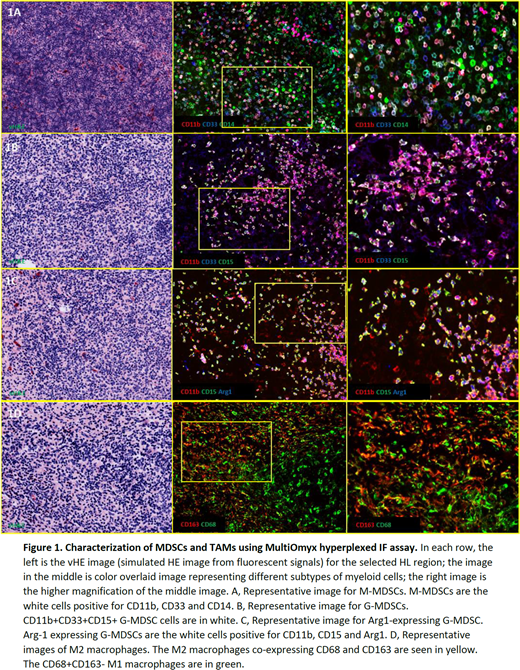Abstract
Tumor microenvironment (TME) consists of heterogeneous subsets of myeloid cells and plays a crucial role in promoting cancer development and metastasis. Tumor associated macrophages (TAMs) and myeloid-derived suppressor cells (MDSCs) all contribute to an immunologically permissive microenvironment for cancer cells. On basis of the expression of surface markers, MDSC can be further subdivided into granulocytic MDSC (G-MDSC, polymorphonuclear MDSC) and monocytic MDSC (M-MDSC). In solid tumors, these different myeloid cell populations are well characterized and extensively studied. However, in hematological malignancies the role of myeloid cell subsets has been less studied. A recent study showed increase in MDSC in the bone marrow (BM) at time of diagnosis in acute myeloid leukemia (AML) patients (Sun H. et al. Int J Hematol. 2015). Significantly higher numbers of G-MDSC and M-MDSC were present at diagnosis in classic Hodgkin lymphoma (cHL) (Romano A. et al. Br J Haematol. 2015). The accumulation of TAMs was also reported to be associated with poor prognosis in cHL (Steidl C. et al. N Engl J Med. 2010). Collectively, these results indicate that the tumor-resident myeloid cells play an important clinical role, thus highlighting the need for monitoring and deeper characterization of various myeloid subsets in hematological malignancies, especially in the tumor FFPE sections.
Herein, we report an analysis of MDSCs and 'protumoral' M2 macrophages using MultiOmyx hyperplexed immunofluorescence (IF) assay in 9 clinical samples diagnosed with HL. MultiOmyx is a proprietary multi 'omic' technology that enables detection and visualization of up to 60 biomarkers on a single 4µM FFPE slide (Gerdes MJ. et al. PNAS 2013). The HL FFPE sections were stained with a 13-marker panel including Arginase 1, CD11b, CD14, CD15, CD16, CD33, CD68, CD163, HLA-DR, CD3, CD4, CD8 and FOXP3. We observed that both M-MDSC (Fig 1A, characterized as CD11b+CD14+CD15-CD33+HLA-DR-) and G-MDSC (Fig 1B, identified as CD11b+CD14-CD15+CD33+HLA-DR-) accumulated within the TME in all 9 HL samples, with higher frequency of G-MDSCs over M-MDSCs. Arg1 expression was detected exclusively in G-MDSC population (Fig 1C). The data also revealed an abundant M2 macrophages (Fig 1D, characterized as CD68+CD163+) present in all HL samples. The detection of both MDSCs and M2 macrophages in HL samples supports the hypothesis that these cells contribute to the establishment of an immunosuppressive TME. Using the MultiOmyx proprietary algorithm, which takes into account the staining patterns, we will next quantify the counts and density of different tumor-resident myeloid subsets and measure the spatial distance between each subset of tumor-resident myeloid cells to the neoplastic Reed-Sternberg cells. Correlation study will also be performed to determine if significant correlations exist between MDSCs and TAMs and how these immunosuppressive myeloid cells are related to the Regulatory T cells (CD3+CD4+FOXP3+) in HL samples. In addition to HL samples, the same 13-plexed panel will be utilized to characterize the myeloid cell population from AML patients.
TAMs and MDSCs are emerging as potential biomarkers for diagnosis and prognosis of cancer as well as therapeutic targets. The comprehensive myeloid cells phenotyping offered by MultiOmyx 13-plexed panel has the potential to monitor the changes of immunosuppressive myeloid cells in response to immune modulating drugs such as MDSC-targeting drugs (e.g. PDE-5 inhibitors, COX-2 inhibitors), TAM-targeting agents (e.g. anti-CSF1R) and combined therapy in treatment of lymphoma and leukemia.
No relevant conflicts of interest to declare.
Author notes
Asterisk with author names denotes non-ASH members.


This feature is available to Subscribers Only
Sign In or Create an Account Close Modal